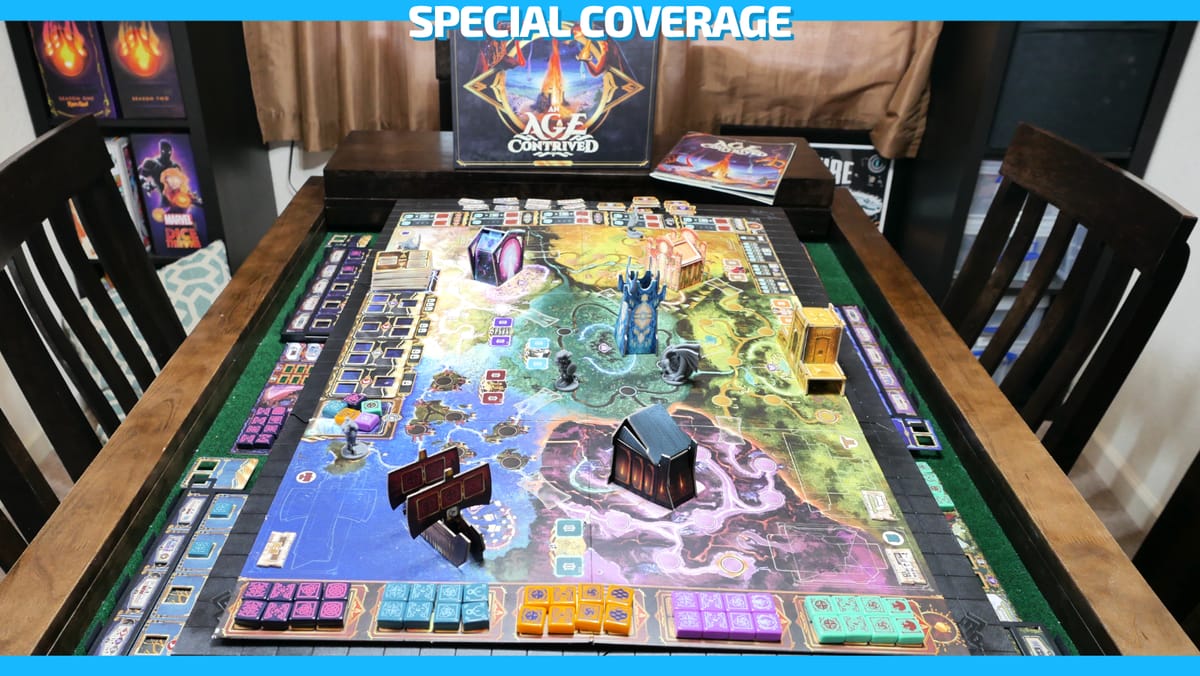
I will be the first to admit that I am drawn into a game’s aesthetic to a fault, at times. That the way a game looks can sometimes override concerns of how it might play. The allure of deluxe components or metal coins; these things are utter catnip to me, and my Kickstarter pledge history can attest to that. Now, this means that sometimes I end up with a game that looks amazing, but just doesn’t play well enough to get to the table very often, or sometimes even at all. It has happened enough to where I feel a little trepidation when I see a new game that looks just gorgeous. Does it play as good as it looks?
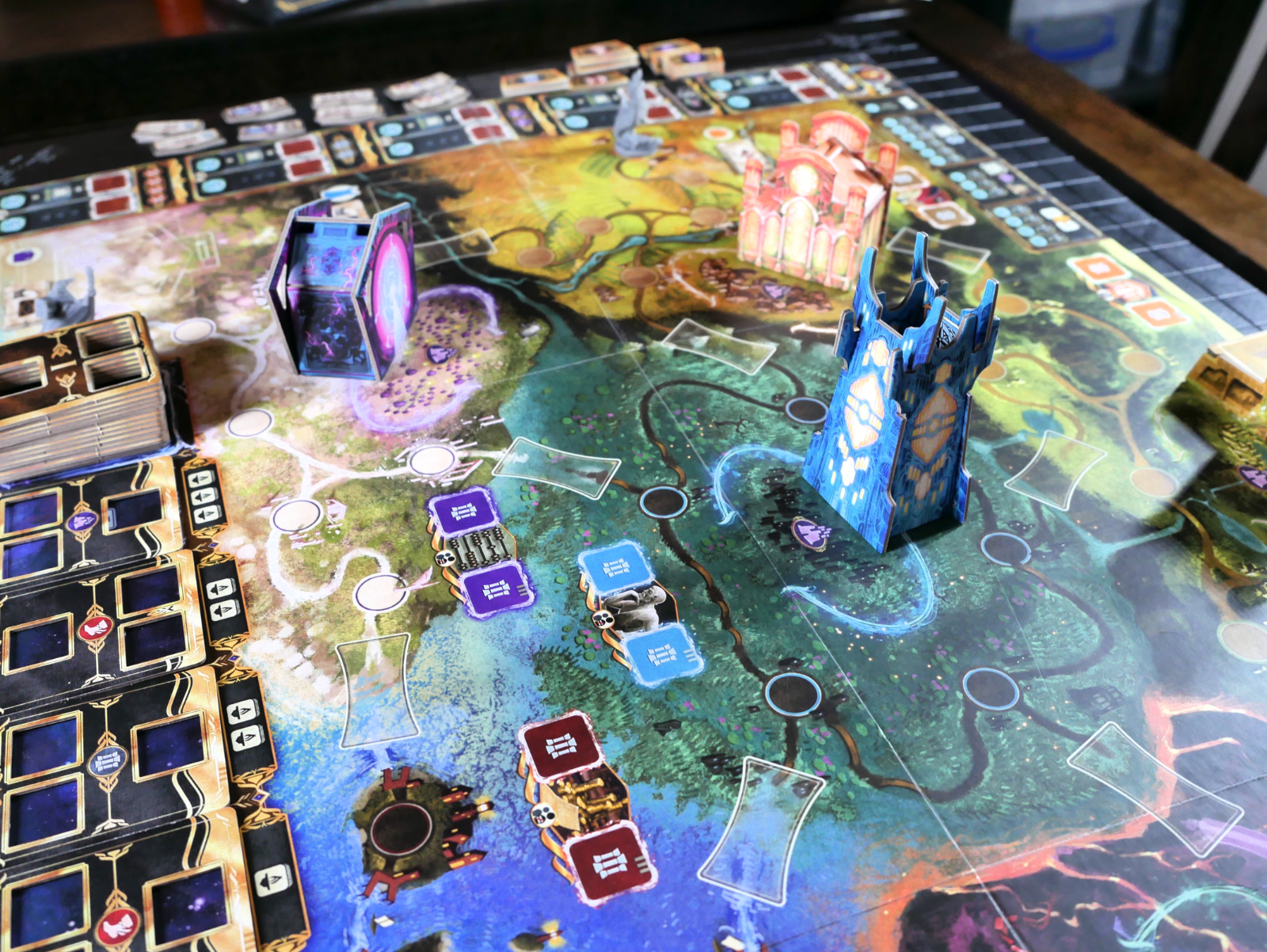
An Age Contrived, a game created by a fledgling studio on its first crowdfunding campaign, is exceptionally beautiful. From the table presence of the vertical magnetic monuments, to the chonky Azul-like tiles, to the beautifully sculpted minis and lush visual design adorning the cardboard, this game is just downright handsome. Even the prototype provided to us could pass for a final product, it looked so good!
But does it play as good as it looks? Happily, YES.
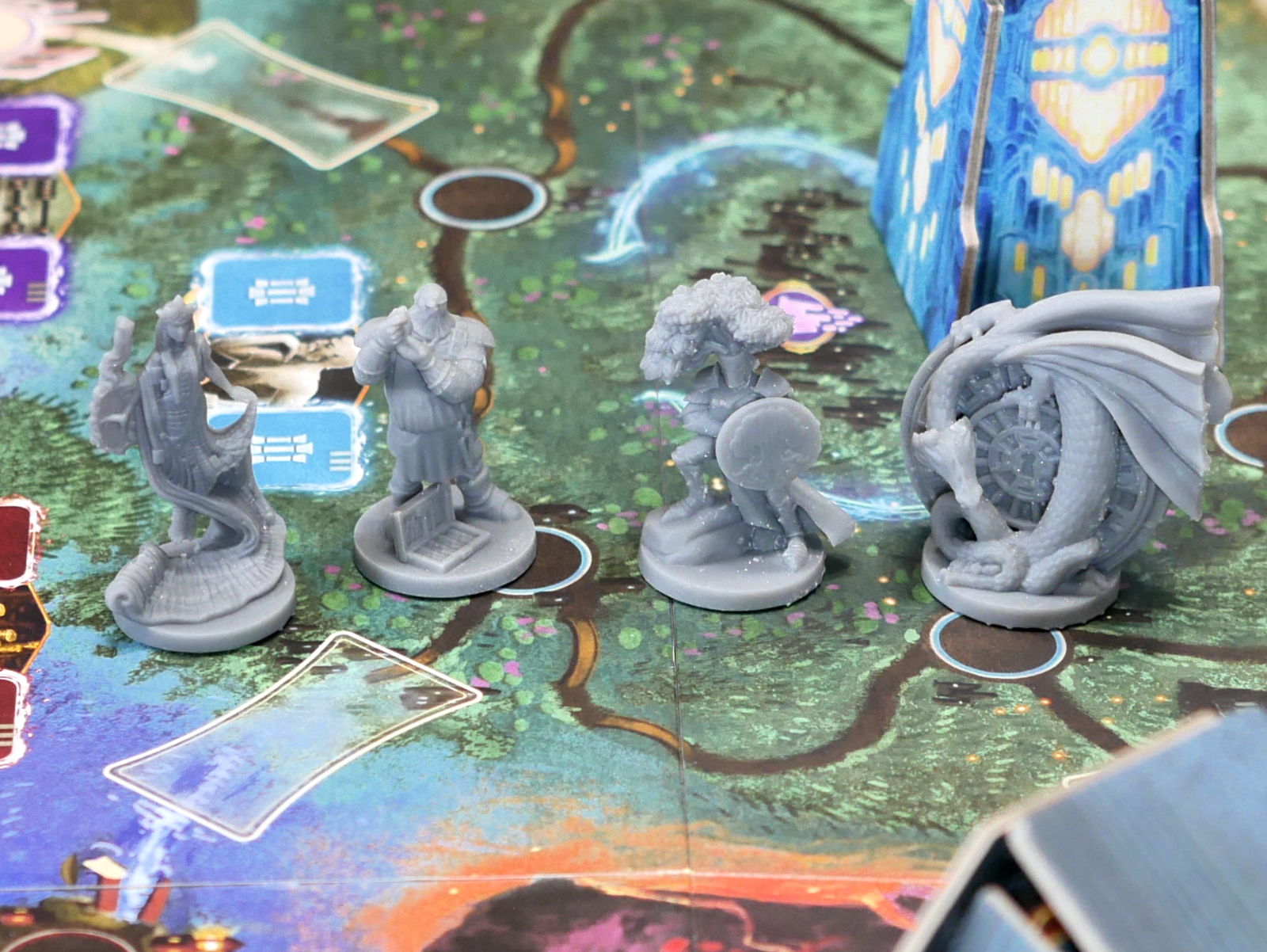
In An Age Contrived, players take on the roles of gods ruling over the realm of Eldranir, influencing the mortal tribes to construct enduring structures in their honor. Up to five can play, and it surprisingly works well at any player count (though single player mode was not available to play yet). Each player gets an avatar of their god for the board, a corresponding character board, channel marker, link tokens, energy tokens, and a player board, also known as the Transmuter Device.
This game is, at its core, a traditional Eurostyle engine builder/programmer. It’s all about resource management and player interaction is passively co-operative for the most part. A layer of asymmetry is introduced via unique character abilities that become unlocked by placing link tokens on the game board to bridge the different regions of Eldranir. Unlike most Euros, however, An Age Contrived has only one resource- energy tokens, though the four different inscribed icons representing types of energy do help to add some depth and differentiation.
The transmuter device is the primary means by which players interact with the game, the mechanics of which determine what each player does on their turn. The device has three rows: The bottom row contains your action tiles. All players always start the game with the same actions, and these can be upgraded during the course of the game. The top row contains empty slots for conduit tokens, which can help provide bonus move actions. The middle row -the Channel- is basically a conveyor belt: It holds five Transmutation Tiles, large cardboard tiles with slots for energy tokens. Every player starts with the same seven Transmutation Tiles, with these five in the Channel in precise order, and two additional tiles that can be cycled in later. Players start the game with the first three tiles filled with the energy tokens of their choice. On their turn, a player must either advance their Transmutation Device, or take one or more actions.
In order to perform one of the five actions on the bottom row, an energy token must be in a slot on the lower half of the Transmutation Tile in that column. You can perform as many of these actions on your turn as you have corresponding energy tokens. Some of these action tokens at the bottom offer a choice, either/or, and some allow you to do multiple things. The five actions that can be taken are Deploy, Reposition, Recharge, Move, and Claim.
By far the most important action, Deploy appears on two of the action tokens, in the first column and on the third column. This is how players move their energy tokens to the various spaces on the board. First, exhaust the corresponding token on the bottom row of the transmutation tile and place it back in your pool on your character board. Then you place all of the energy tiles in the top rows of the transmuter tiles on the board that match the action tile – either in the Dimensional Corridor, on an achievement slot – provided the achievement parameters have been met – or on an incomplete monument section.
While the first option on Action tile number one is Deploy, the second is Recharge (and one of the upgrades actually allows you to do both). Recharge allows you to flip your channel marker over on your character board from the exhausted side to the charged side. A charged channel marker can provide an additional Advance and bring a second transmuter tile into your device.
Reposition is one of the two options on Action tile 2 (The other being Claim, which we’ll talk about in a second). Basically, this allows you to take up to a certain number of your energy tiles already on the board and reposition them elsewhere on the board (namely between the Dimensional Corridor, monument sections, or achievement slots). This is great for when you realize you may have made a less optimal deployment earlier in the game, or if you decide to change your strategy halfway through. This eases the pressure a bit on getting each deployment perfect.
Action tile 4 is the Move action (tile 3, as mentioned earlier, is a second deploy action). Once again, exhaust the tile from the bottom row and then you have a choice: Move your avatar on the board or move or place a tile on one of the two tracks on your character board, the Sentient track or the Transformative track. Moving up these tracks allows you to bind energy tokens to the bound energy zone of a monument or to one of the Pillars of Civilization. Both contribute points to end game scoring.
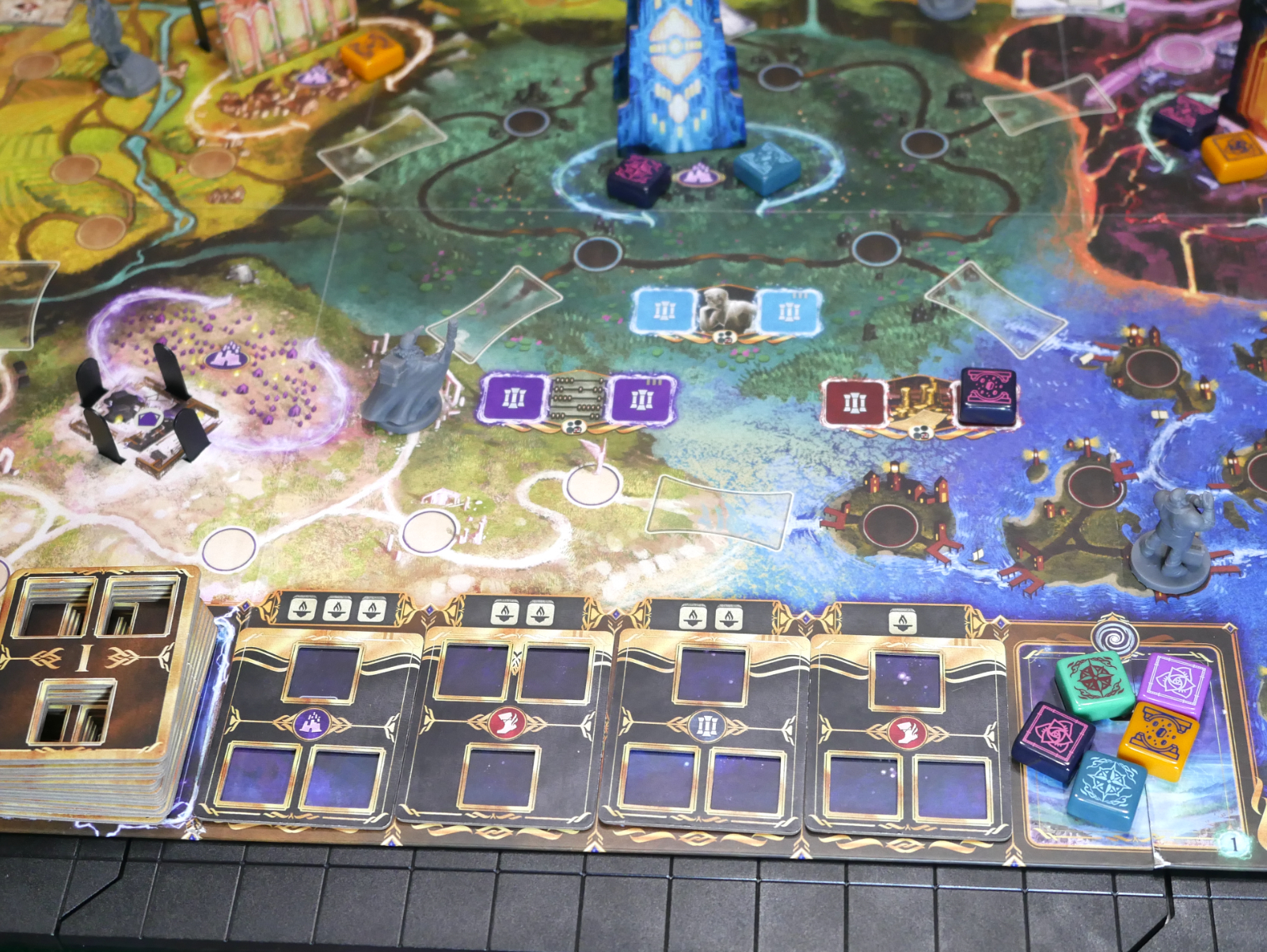
The Dimensional Corridor
Finally, I want to return to the other action on tile two: Claim. This is how you upgrade your Transmutation tiles and get more slots for energy tokens as well as Conduit icons that contribute to achievement parameters and bonus move actions. Remember all of those energy tokens you’ve been banking in the Dimensional Corridor? Well, now you can spend them on up to two face up Transmuter tiles, at a cost matching the icons above the tile slot. Spent tiles go into your exhausted pool, and your newTransmuter tiles replace the same number of tiles from the 7 total in your machine. Replaced tiles are put back into the box and any energy tokens left on it are exhausted. All remaining transmuter tiles are slid to the right of the Corridor and replacements are drawn from the tile deck face-up on the left. Then, any opponent with a tile already in the Dimensional Corridor has an option to place one exhausted tile from their pool into the corridor, banking that tile for a future Claim action. Any tiles remaining in the Dimensional Corridor at the end of the game are also worth a point each.
When you run out of energy tiles on your device, you’ll need to take an Advance turn instead of taking actions. This is where the conveyor belt concept comes into play. When you take an Advance turn, you select one of your two inactive Transmuter tiles and slide it into the first position of your device, pushing the rest of the tiles to the right until the far one exits the device. Any energy on that tile is immediately exhausted. The newly placed tile in position one now gets energy tokens on all slots on both rows. As noted before, if you have a charged Channel marker you can take a second Advance action.
Taking the Deploy action is by far the most consequential and important thing a player does during their turn. Deploying is the only way to build monuments, which are the other main focus of the game. Building these monuments, section by section, enable players to unlock more energy tiles from their reserve, gain one-time benefits such as gaining link tokens or moving your avatar through the mortal realm, and unlocking the full potential of the different types of energy placed once the monument section is complete. The god that completes a section of a monument gets to place it on the board, then binds their completing token to the monument, which takes it out of play but scores points in the endgame.
Each monument section assembles magnetically in an unbuilt state and has a designated place on the board. The section also displays the default benefit that each player who placed a token receives once all token slots have been filled. Next to each unbuilt monument is a space for a randomly placed additional benefit token. This benefit can be taken in lieu of the default benefit depicted on the monument section. Once a player places that last energy token on the monument section, the first player to the left with a token on the section chooses their benefit, and this continues in clockwise order. If a player has multiple tokens on the monument section, they only receive the chosen benefit once. As each energy token is removed, the player can then choose to activate the token based on the energy type represented.
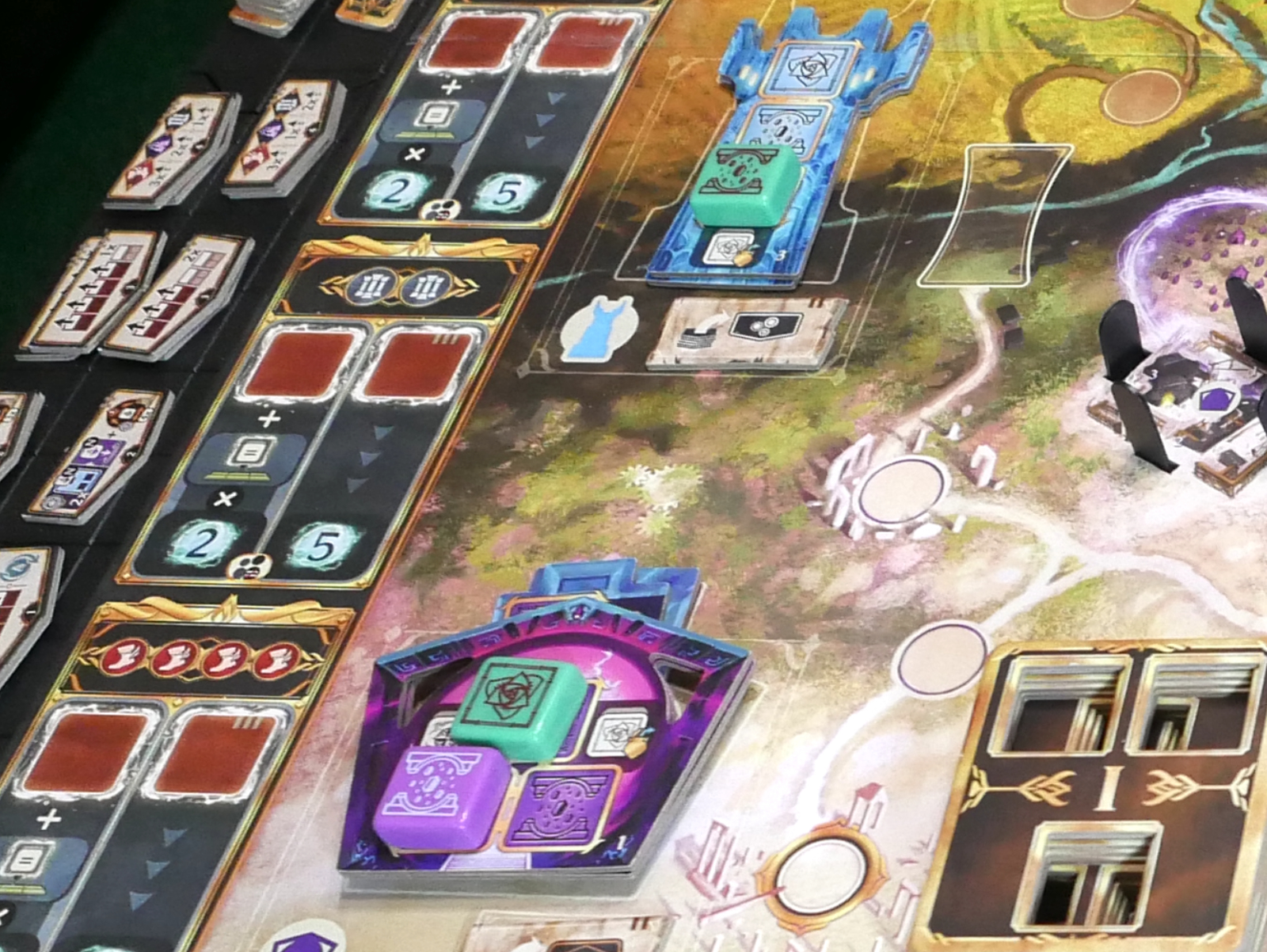
Monument sections with energy tokens
There are four different energy types, and three of them have special activation abilities that can only be triggered by completion of a monument section. One energy type simply allows for that token to be redeployed on the board. Another type allows you to replenish your transmuter device, while the third allows you to take an extra move action on the board or on the progression tracks on your character board. Finally, each player has their own Primal Energy type, represented by their player icon. When this energy token is allocated to a monument, it is considered wild and can be used on any icon slot. While it doesn’t have its own activation energy, each player has a unique ability associated with it once they gain their tier-1 Link token and place it on the board.
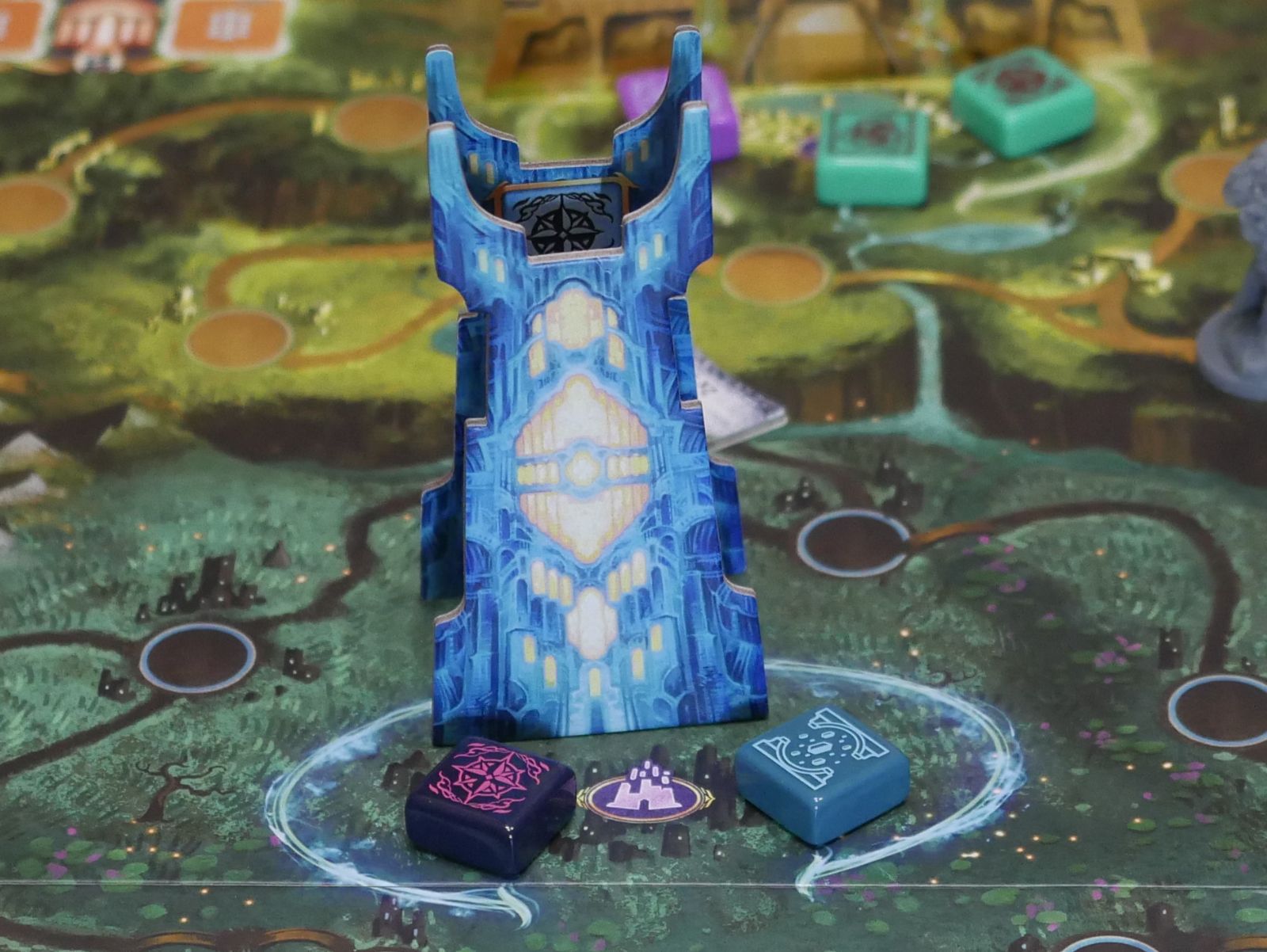
Energy tokens bound to a monument on the board
The player who completed the monument section does not activate the last token placed, instead, that energy token is bound to the monument until the end of the game, scoring points for the player after the end of the game is triggered. The end of the game is triggered when the last section of the last monument is built, allowing for the other players to take one last turn if they didn’t get the same number as the player who ended the game.
Despite how polished the prototype was, it was very clear that Chris Matthew and his team were still working on the game even up to and after the Kickstarter launch. We were getting rules clarifications from one game to the next at times, which just tightened things up from session to session. Some notable patterns did emerge after multiple plays: several games started off with a mad dash to nab up all of the good transmuter tiles before everyone else did, for instance. It was also a little odd at how most of the action on the game board revolved around building monuments more than moving your avatar miniature around on the board. It’s a big board!. These are nitpicks, however, and the tactile joy of snapping a piece of a monument magnetically to its corresponding metal frame jutting up from the board was the one thing every player seemed to agree was a satisfying highlight of the game.
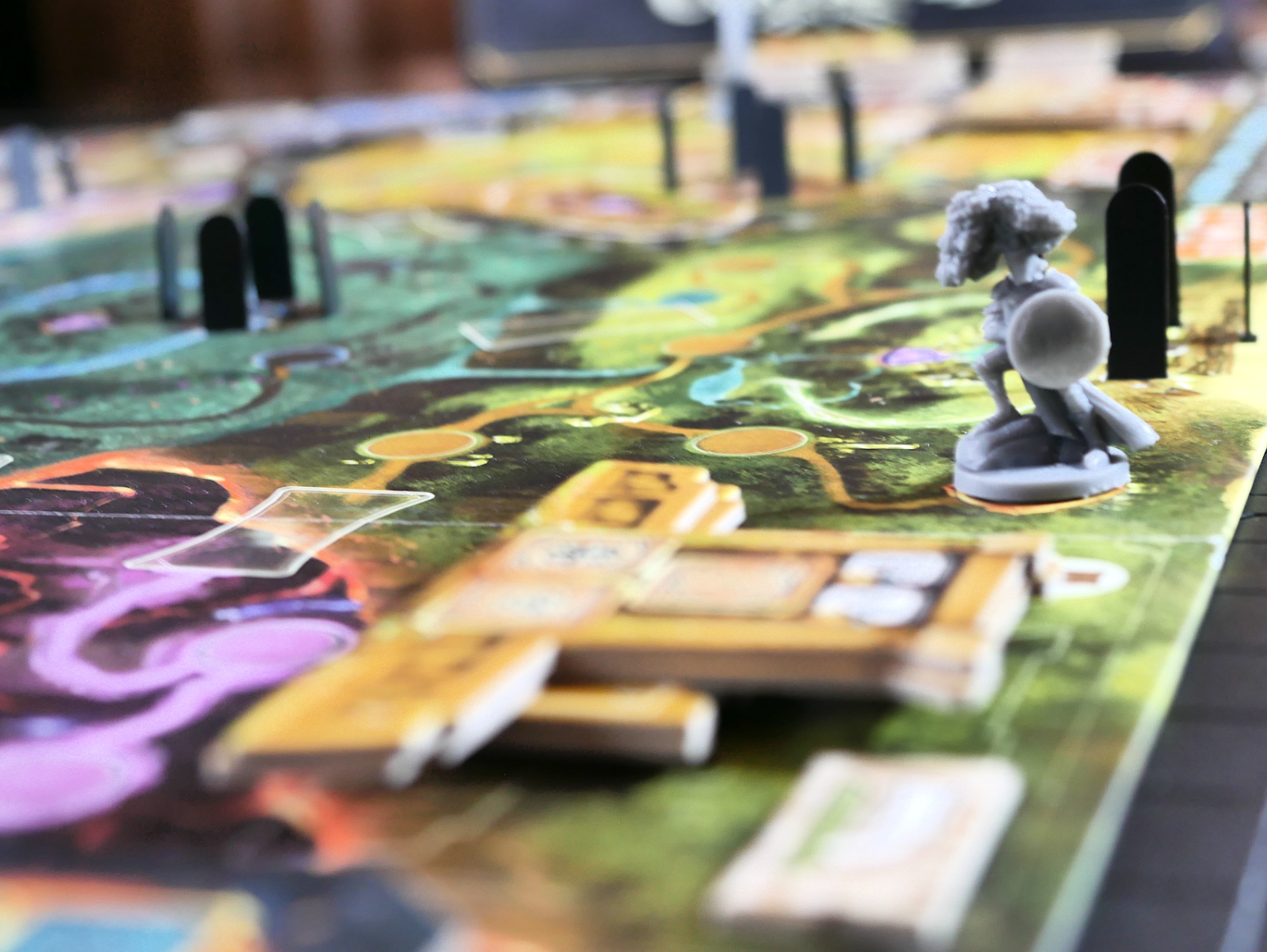
I think An Age Contrived is a rare creature- a game that both plays and looks amazing. From the verticality of the monuments, to the pleasantly tactile placement of energy tokens around the board, this game does a great job of bringing some new tricks together with familiar mechanics. I’m also very curious about the solo mode, and post-Kickstarter expansions have been hinted at. The Kickstarter ends very soon, but expect this one to come to retail eventually if you miss out on pledging. Pledge!